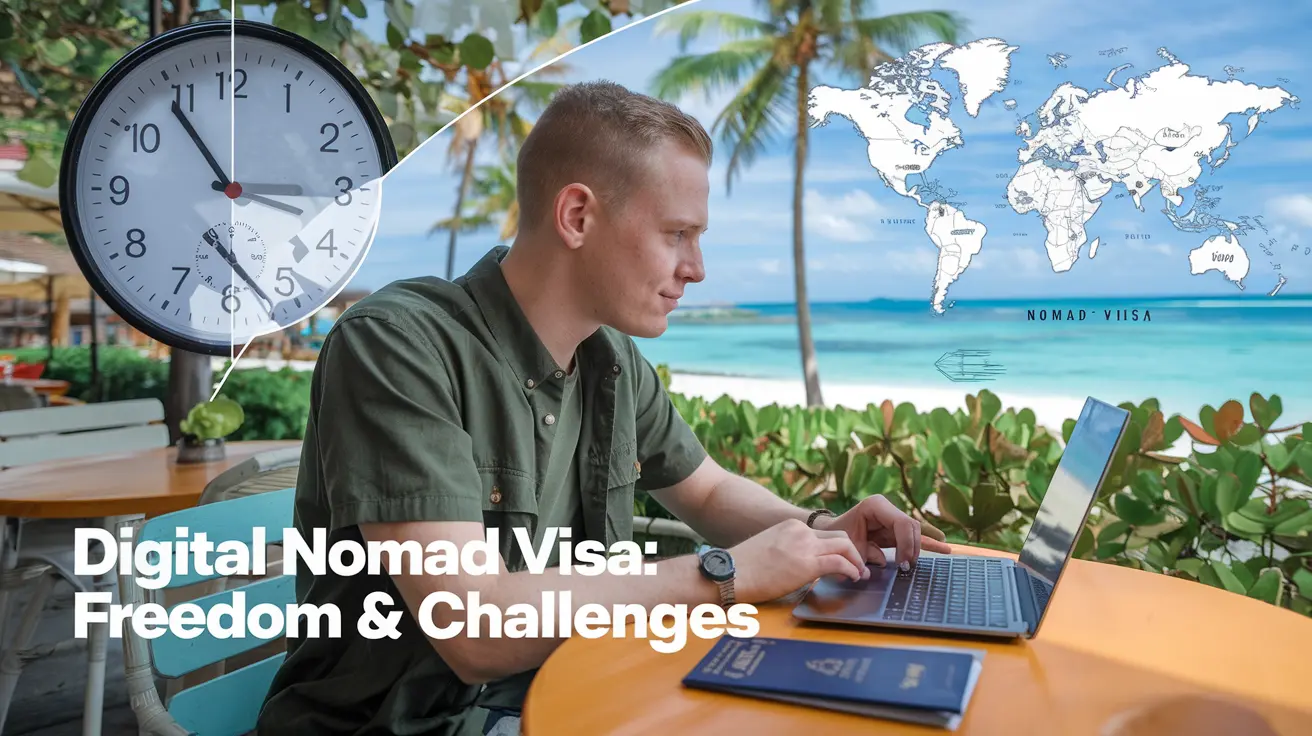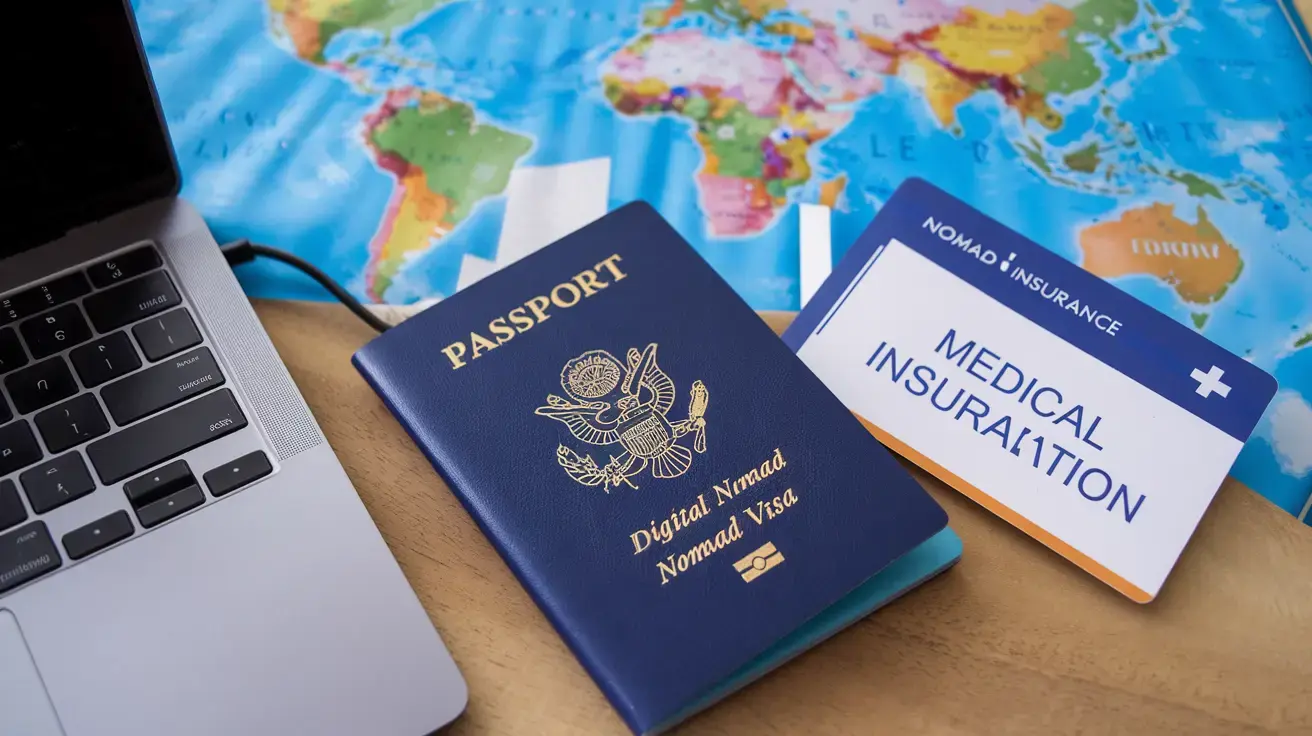Digital Nomad Visa
As of 2025, this dream has become increasingly accessible for US citizens through digital nomad visas – specialized permits that allow remote workers to legally reside and work in foreign countries while maintaining their employment with US-based companies.
The post-pandemic world has witnessed an explosion in remote work opportunities, with over 66 countries now offering digital nomad visa programs tailored for location-independent professionals.
But is this lifestyle of freedom and global exploration truly as idyllic as it seems? While the ability to travel anywhere at any time and potentially benefit from significant cost savings through geo-arbitrage sounds enticing, digital nomadism also comes with challenges – from navigating complex health insurance requirements to dealing with time zone differences and potential social isolation.
In this comprehensive guide, we’ll explore everything US citizens need to know about digital nomad visas – from understanding what they are and how they differ from tourist visas, to breaking down the application processes, examining the key benefits and drawbacks, and highlighting the most popular destinations where Americans are establishing their mobile offices in 2025.
Whether you’re contemplating a short-term adventure or a complete lifestyle transformation, this information will help you make an informed decision about joining the digital nomad movement. 🌎
Understanding Digital Nomad Visas
What is a digital nomad visa and how it differs from tourist visas
A digital nomad visa is a specialized permit allowing remote workers to legally reside in a foreign country while earning income from sources outside that country. Unlike tourist visas, which typically restrict any form of work and limit stays to 90 days, digital nomad visas are specifically designed for remote workers and offer longer durations—usually 12 months with renewal options.
These visas require proof of steady income from non-local sources and sometimes health insurance, whereas tourist visas generally only require proof of sufficient funds for your stay and return transportation.
Growth of digital nomad programs post-COVID-19
The COVID-19 pandemic dramatically accelerated the adoption of digital nomad programs worldwide. According to MBO Partners, the global digital nomad population surged from 10.9 million in 2020 to an impressive 35 million by 2024.
This exponential growth reflects both changing work cultures embracing remote arrangements and countries recognizing the economic benefits of hosting high-earning professionals who contribute to local economies without competing for local jobs. As remote work became normalized, more governments developed specific visa programs to attract these location-independent workers.
Current countries offering digital nomad visas in 2025
As of 2025, approximately 66 countries worldwide offer digital nomad visas, with concentrations in Europe and the Americas. Popular destinations for US digital nomads include Spain, Portugal, Croatia, and Estonia in Europe, while Costa Rica and several Caribbean nations offer appealing options closer to home. Income requirements vary significantly—some countries like Germany and the Bahamas impose no minimum thresholds, while others like Albania ($815) and Colombia ($750) keep requirements accessible.
European options like Spain require around $2,565 monthly, while Norway demands a substantial annual income of approximately $40,500.
Typical duration and renewal options
Most digital nomad visas initially grant a one-year stay, though durations range from six months to three years depending on the country. The Netherlands stands out by offering a three-year visa under specific conditions for self-employed individuals.
Renewal policies vary significantly Portugal allows renewals up to four times (potentially five years total), while other countries may limit extensions or require temporary departures before reapplication. Some nations also offer pathways to permanent residency for digital nomads who wish to settle long-term, though this typically involves meeting additional requirements beyond the initial visa conditions.
Now that we’ve explored what digital nomad visas are and which countries offer them, let’s examine the specific application processes and requirements you’ll need to navigate as a US citizen looking to embark on this lifestyle.
Application Process and Requirements
Now that we understand what digital nomad visas are, let’s dive into the application process and requirements that US citizens need to navigate. While the United States itself doesn’t offer a dedicated digital nomad visa for visitors, US citizens have numerous options abroad with varying application procedures.
A. Eligibility criteria for US citizens
Most countries offering digital nomad visas require applicants to be at least 18 years old and hold a valid US passport. Some nations may have additional requirements such as a clean criminal record or proof of good health. The eligibility criteria can vary significantly between countries, with some being more stringent than others. For instance, some European countries may require proof of accommodation or a return ticket, while others might have language proficiency requirements.
B. Income requirements and proof of remote employment
Income requirements are a crucial aspect of digital nomad visa applications. Countries typically set minimum monthly income thresholds to ensure that visa holders can support themselves without burdening local resources. These thresholds can range widely, from approximately $1,000 to $5,000 per month depending on the country’s cost of living. US citizens must provide documentation proving their remote employment status, such as:
- Employment contracts with US or international companies
- Freelance client agreements or ongoing contracts
- Business registration documents for entrepreneurs
- Bank statements showing consistent income
- Tax returns from previous years
Remote work verification is essential, as these visas specifically target individuals who earn their income from sources outside the host country.
C. Necessary documentation (passport, health insurance, criminal record)
When applying for a digital nomad visa, US citizens typically need to prepare the following documents:
- Valid US passport with at least 6-12 months validity beyond the intended stay
- Comprehensive health insurance with international coverage, including COVID-19 treatment in most cases
- Criminal background check or police clearance certificate from the US
- Proof of accommodation for at least the initial period of stay
- Digital copies of identity photos meeting specific format requirements
- Civil documents such as birth certificates or marriage certificates if applying with dependents
Many countries have specific guidelines for document presentation, potentially requiring apostilles or official translations for US-issued documents.
D. Application costs and timeline
The costs associated with digital nomad visa applications vary significantly across countries. Application fees typically range from $200 to $2,000, with some countries charging more for processing family applications. Additional costs may include:
- Document authentication fees
- Translation services
- Health insurance premiums
- Embassy appointment fees
- Visa extension fees if staying longer than initially approved
The timeline for processing digital nomad visa applications generally takes about one month, though this can vary significantly depending on the country and application volume.
Some nations offer expedited processing for additional fees. Most digital nomad visas remain valid for one to two years, with potential extensions available in many cases.
E. Family application options for dependents
Many countries allow digital nomads to include immediate family members in their visa applications. Typically, spouses/partners and dependent children under 18 can be included, though some countries extend this to older children if they remain financially dependent. The documentation requirements for dependents usually include:
- Marriage certificates for spouses
- Birth certificates for children
- Proof of guardianship where applicable
- Individual health insurance coverage
- Additional financial requirements to demonstrate the ability to support dependents
Some countries may impose higher income requirements for applicants with dependents, ensuring the entire family can be adequately supported during their stay.
With a clear understanding of the application process and requirements, US citizens can now better evaluate if pursuing a digital nomad visa aligns with their professional and personal goals.
Next, we’ll explore the numerous benefits that digital nomad visas offer to US citizens, including lifestyle advantages, tax implications, and networking opportunities.
Benefits of Digital Nomad Visas for US Citizens
Now that we’ve covered the application process and requirements for digital nomad visas, let’s explore the significant advantages these visas offer to US citizens seeking a location-independent lifestyle. Digital nomad visas provide numerous benefits that make them increasingly attractive options for remote workers looking to expand their horizons beyond traditional work environments.
A. Extended Legal Stays Beyond Tourist Visa Limits
Digital nomad visas allow US citizens to legally reside in foreign countries for significantly longer periods than standard tourist visas permit. While tourist visas typically restrict stays to 30-90 days, digital nomad programs offer extended residency ranging from one to three years. For example, the Netherlands provides a three-year visa under specific conditions, while Portugal’s visa allows residency for a year and is renewable up to four times. This extended legal status eliminates the stress of visa runs and border-hopping that many digital workers previously faced when attempting to maintain long-term stays abroad.
B. Freedom to Work and Travel Simultaneously
One of the most compelling advantages of digital nomad visas is the legal authorization to work remotely while exploring new countries. Unlike tourist visas, which technically prohibit any form of work (even remote work for overseas employers), digital nomad visas explicitly permit remote work activities. This legitimizes the digital nomad lifestyle, allowing US citizens to perform their jobs without concerns about violating immigration laws. For instance, Estonia offers both short-term C visas for stays under 90 days and long-term D visas for up to one year, both specifically designed to accommodate remote workers while they experience Estonian culture.
C. Potential Tax Advantages and Considerations
Digital nomad visas can offer significant tax benefits for US citizens, though the specifics vary by country. While Americans must still file US taxes regardless of where they live (due to citizenship-based taxation), some host countries offer tax exemptions or reduced rates for digital nomads. Croatia, for example, provides specific tax exemptions for digital nomad visa holders.
Other countries may have favorable tax treaties with the US that can help prevent double taxation. However, it’s important to note that tax implications are complex and depend on individual circumstances, the host country’s regulations, and the duration of stay.
D. Cultural Immersion Opportunities
Living in a foreign country through a digital nomad visa provides unparalleled opportunities for cultural immersion that short-term tourism simply cannot match. Extended stays allow US citizens to develop deeper connections with local communities, learn languages more effectively, and gain authentic cultural experiences.
This immersion goes beyond surface-level tourism, offering digital nomads the chance to develop genuine understanding of different lifestyles, traditions, and perspectives. The global digital nomad population has grown dramatically from 10.9 million in 2020 to 35 million in 2024, reflecting the increasing desire for these enriching cross-cultural experiences.
E. Geo-Arbitrage Benefits and Cost Savings
Digital nomad visas enable US citizens to take advantage of geo-arbitrage—earning in dollars while living in countries with lower costs of living. Many popular digital nomad destinations offer significantly reduced expenses compared to major US cities, allowing for substantial savings or lifestyle upgrades. Countries like Spain are particularly attractive for their affordability combined with high quality of life.
Other destinations with competitive cost structures include Romania, Thailand, and Colombia, where the minimum income requirements are under $2,000 per month. This financial advantage allows US digital nomads to potentially save more, work less, or enjoy a higher standard of living than they might achieve domestically.
With these significant benefits in mind, it’s important to also consider the potential challenges and drawbacks that US citizens might face when pursuing the digital nomad lifestyle through specialized visas.
While the advantages are compelling, there are several important factors to evaluate before making the leap into international remote work.
Popular Destinations for US Digital Nomads
European Options (Portugal, Spain, Croatia, Greece)
Now that we’ve covered the benefits digital nomad visas offer US citizens, let’s explore the most popular destinations worldwide. In Europe, Portugal stands out with its one-year renewable visa (up to four times) requiring a monthly income of $3,511.
Spain attracts American remote workers with a relatively affordable requirement of $2,565 monthly income and an $88 application fee. Croatia offers a digital nomad-friendly environment with visa requirements under $3,000, while Greece boasts affordable living costs, extensive 5G coverage, and a vibrant expat community.
Latin American Opportunities (Costa Rica, Argentina)
Latin America provides excellent options for US digital nomads seeking warmer climates. Costa Rica offers a vibrant lifestyle with its one-year renewable visa requiring a minimum income of $3,000 for individuals. The country provides an appealing balance of natural beauty and reliable infrastructure. Colombia represents one of the most affordable options with a minimum income requirement of just $750, making it highly accessible for US citizens beginning their digital nomad journey.
Asian and Middle Eastern Choices
Asia and the Middle East present diverse opportunities for US digital nomads. Indonesia, particularly Bali, has become a digital nomad hub with reasonable living costs and a thriving expat community.
Thailand offers the 180-day Destination Thailand Visa designed specifically for remote workers. South Korea provides a digital nomad-friendly environment with excellent internet infrastructure. In the Middle East, countries are increasingly developing programs to attract remote workers, though specific requirements vary significantly across the region.
Caribbean Destinations
The Caribbean offers US digital nomads proximity to home with tropical paradise settings. The Bahamas stands out for having no minimum income threshold for their digital nomad visa, making it accessible for many Americans. Other Caribbean nations provide similar visa programs, attracting US citizens with their beautiful beaches, relaxed lifestyle, and the convenience of remaining in a time zone compatible with US-based clients and employers. These destinations typically require proof of remote employment and health insurance.
Comparing Visa Requirements Across Regions
When comparing digital nomad visa requirements across regions, significant variations emerge. European countries generally have higher income thresholds, with Norway demanding approximately $40,500 annually, while Malta requires $45,233. Latin American destinations tend to be more affordable, with Colombia’s $750 minimum being among the lowest globally. Application fees also vary dramatically, from Norway’s substantial $641 to Spain’s modest $88.
+Duration also differs, with the Netherlands offering a generous three-year visa versus the typical one-year permits with renewal options found in countries like Portugal and Costa Rica.











